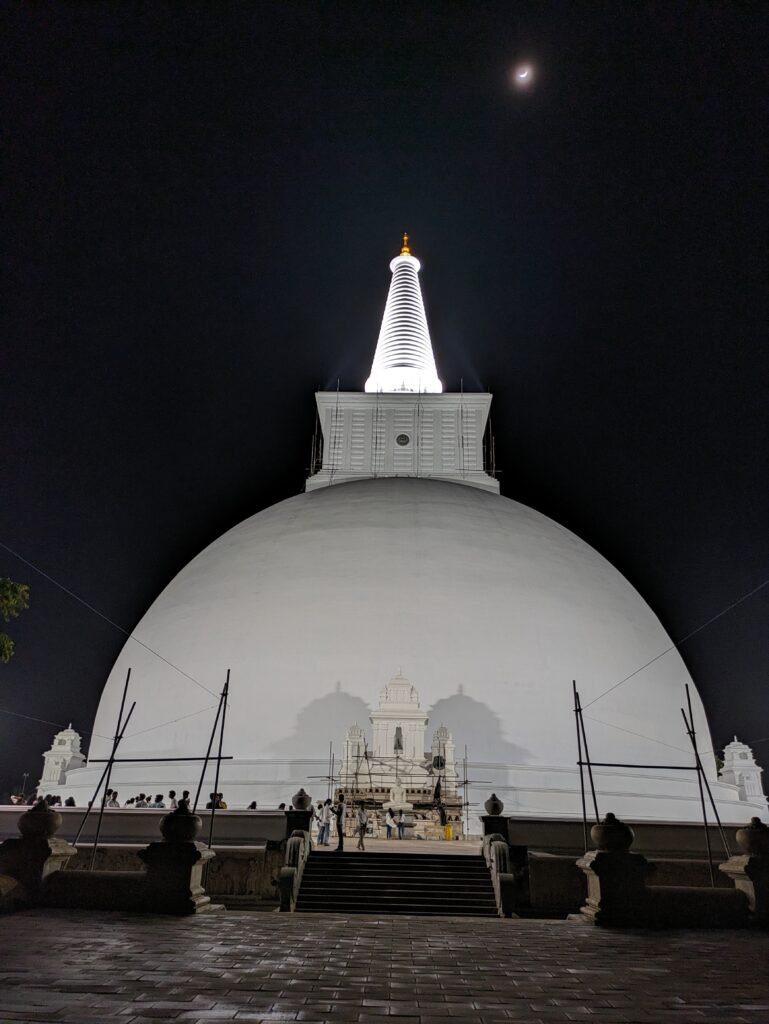Anuradhapura, Sri Lanka #41

June 12,
Today we awoke and readied for a full venture after our coffee/hot chocolate, of course. We left around 0830. First we did stop at a Keells grocery store for our breakfast. We each had a yogurt and three pastries we split: one was a creamy garlic glazed (that is right garlic) savory doughnut, a smoky BBQ glazed savory doughnut, and a chocolate, chocolate chip muffin. It was a very eclectic breakfast but it was super great! Now we set out! We are going to the main site here, Ancient Anuradhapura, the Sacred Precinct, a UNESCO World Heritage Site. Our host gave us a heads up of where to start – the museum; and to wear socks – because we will have to take off our shoes and it will be hot on our bare feet!
We arrived at the Jetavana Museum. Here we bought our tickets for the huge site. It is a very hefty price for foreigners $30 each!!! The tickets are good for today only, so yeah we will go over budget today. I guy had approached Jeff to be our guide. Jeff took him up on it – since it is so large a complex and we are paying so much already. The guide, Chamal, wanted $20 for all day — as long as we go! We started in the museum.
It has three galleries of items found here: #1- Stone sculptures, such as carvings of mythical creatures at various places in this site, a great guardstone, and of course- Buddha statues; #2- Ancient artifacts, such as jewelry, brass idols, ivory carvings, and engravings on semi-precious stones; #3- Clay works, such as some bricks used for the stupas, earthen jugs and large pots, and an elegant grape-vine engraved vessel from Persia, dated from the 3rd Century A.D.. No photos were allowed inside the museum. Chamal explained some of the more important pieces as we went through. He speaks English well, thankfully! We left the museum, all three of us getting into our itty-bitty “CB” (I’m calling it this because of the brilliant cobalt blue color.) Chamal directs us to the first site, The Jetavana Stupa.
This stupa or dagoba, is massive, all red-brick. Originally it stood 120m tall and at it’s construction time was the third tallest structure in the world – the two great pyramids of Giza being numbers one and two! It is still the largest structure made entirely of brick – over 90 million bricks! It now only stands 70m tall, but still is impressive. It has lost it’s once white outer shell due to pilfering and negligence… I’m going to digress now, a bit of history.
Anuradhapura was – for over 1,000 years – early Sri Lanka, before it was Sri Lanka from 377 BC to 993 AD (when Indian invaders conquered). The kings of Anuradhapura ruled from here, overseeing the golden age of Sinhalese culture. Three main monastery areas were also here, having upwards of 10,000 monks, making it one of the greatest monastic cities of the world. So great feats of architecture were achieved – one being the Jetavana Stupa. There was also great Sinhalese hydraulic achievements, making vast reservoirs (tanks) to keep water in long dry seasons for all the people, around one million people, and for irrigation for rice paddies. After the Indian invasion, much of this area moved to another city. Now comes the pilfering and neglect. Some locals that stayed started repurposing the bricks, stones, whatever they found that had been abandoned. Then time took its toll: forests and plants grew on and around the buildings; the elements also weathered and weakened structures, causing collapses. Locals still knew of the area but others forgot it. The British (re)”discovered” it in the 1800’s. In1833, they made it a provincial capital and slowly the ancient site started its rise… this is a quick synapsis from various flyers we had acquired on site and a Rough Guide book (like a Lonely Planet) that our homestay let us borrow.








